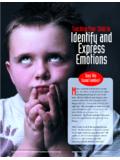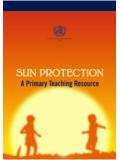Transcription of National Literacy and - UCL Institute of Education
1 National Literacy andNumeracy Strategies:Guidance on TeachingAble ChildrenGuidanceCurriculum & StandardsHeadteachers &TeachersStatus: Information onlyDate of issue: January 2000 Reference number: LNGTR elated documents: National Literacy StrategyFramework for Teachers ( ); Framework for TeachingMathematics fromreception to year six ( )Superseded documents: NoneExecutive summaryOverview:This guidance is intended to advise primary headteachersand teachers on how best to provide for able pupils within theNational Literacy and Numeracy required:Ensure that all staff members involved in thedelivery of the National Literacy and Numeracy Strategies are fullyaware of the content of this information.
2 The guidance will be supplemented withexemplification material which will be made available later in theacademic year 1999 Literacy and Numeracy Strategies: Guidance on teaching Able children The National Literacy and Numeracy Strategies are already proving to be effective tools forraising standards among primary aged children , including able pupils. The 1999 Key Stage 2results showed a significant improvement in the percentage of children achieving level 4 andlevel 5 in English and in mathematics. This guidance gives further help to teachers in providingfor pupils who are more able than the majority in their class in Literacy or mathematics.
3 What do we mean by more able in Literacy and mathematics?Able pupils are quick to understand and apply their knowledge and skills in creative andoriginal ways. The chart illustrates some characteristics of pupils who are particularly ablein Literacy or ability does not always result in high attainment. Able pupils may conceal their abilitybecause of social pressures, becoming reticent in class and difficult to involve. Attainment canbe uneven, for example an outstanding reader may produce writing which is superficial andundeveloped. In key stage one, some pupils develop an early proficiency in reading using sightvocabulary and contextual cues, but lack phonic skills; others may have the ability to producelanguage and ideas for composing texts, but experience problems in can use a range of information to identify able pupils including: tests andexaminations; portfolios of work from previous schools or teachers; and parents perceptionsand pupils self-assessment.
4 Identification should involve balancing these different sources ofevidence and should not be a one-off judgement. It is important to reassess pupils regularlyand to avoid stereotyping, for example by gender. can orchestrate the various readingcues at an early age; are active readers who can generalisefrom their reading experience; latch on quickly to the conventionsof different types of writing; think in original ways and experimentwith new styles; manipulate language, sentence structureand punctuation; use apt terminology and variedvocabulary. generalise patterns and relationshipsand approaches to problem solving; are persistent and flexible in their searchfor solutions; develop logical arguments, often takingvalid shortcuts; use mathematical symbols confidently; rapidly grasp new material; may not be exceptional in carrying outcalculations, but may see calculationsas detail and less important than theproblem as a who are able in.
5 Literacy :Mathematics:2 National Literacy and Numeracy Strategies: Guidance on teaching Able ChildrenUsing the FrameworksThe Frameworks for teaching Literacy and for mathematics summarise the approach towardsteaching able pupils through the Literacy and Numeracy Strategies. The Literacy Framework covers the National curriculum for reading and writing for Key Stages 1and 2, enabling pupils to progress from level 1 to level 5. Similarly, the Framework for teachingmathematics covers the National curriculum for Key Stages 1 and 2 for mathematics frompre-level 1 up to level 4 and includes parts of level 5.
6 Further enhancement of level 5 work isincluded in the Framework for teaching mathematics: Extensionwhich will be sent to schoolsin March 2000. A framework for English for year 7 pupils, building on the primary LiteracyFramework is also being developed and will be available in draft on the Standards websiteby March scope of the Frameworks is wide enough for most able pupils in the primary are catered for by covering objectives: in greater depth ( more detail and complexity) to a broader range ( more challenging texts and tasks) and at a faster pace ( tackling objectives earlier).
7 Organisation in the Literacy Hour and daily mathematics lessonAt whole school level, schools need to generate a positive ethos for able pupils, and anable pupil policy which commands support and commitment from the head teacher, all staff,governors and parents. Schools should have: a co-ordinated approach to implementing their policy; effective identification processes; effective systems for recording, reporting, monitoring and evaluation; and suitable arrangements for staff structure of the Literacy Hour and the daily mathematics lesson allows for class teachingthat meets individual needs and provides for differentiated group and independent work.
8 Withinthe classroom, able pupils need direct teaching and opportunities to work with their involving able pupils should be based on the principle of inclusive whole class andgroup teaching . In some cases, however, you may need to consider other organisational main options are set out overleaf. Schools should consider all of these approachesin determining their response to individual pupils Literacy and Numeracy Strategies: Guidance on teaching Able ChildrenApproachAdvantagesDrawbacksConsi derations teaching assistantneeds to be skilledand confident to beable to support andchallenge pupils Good liaison requiredbetween teacher andassistant Could reduce supportfor other pupils Flexible can beused at differentparts of hourWhere possible an additional adult toprovide simultaneousteaching or support Whether it would besocially and emotionallydemanding for thepupil accelerationmay be moreappropriate forthe oldest pupilsin a year group What happens in Y6or final year?
9 Can usealternative strategies(such as use of ICT) More flexible alternative occasionalopportunities for ablepupils from differentyear groups to meetwithin or outsidelessons fast-tracking a smallgroup may be possiblein larger schools Content and interestlevel might notalways be suitablefor younger pupil Links to rest ofcurriculum oftenweaker becausetopics are out of step Might suit individualable pupil Enables highly ablepupils to progressfurther and faster,so can improvemotivation andself-esteemPlacing in older class(acceleration) Variations on setting: Temporary during revisionsessions Part-time 2 or 3 lessonsper week Have a top set butmixed ability forother groups Age of pupils setting may be moreappropriate as pupilsget older Deployment ofteachers needs to beconsidered to ensurethat low sets alsohave access to goodlevels of expertise If setting is across 2years, need to ensurethat work is not arepeat of previous year Other pupils missout on able pupils contributions (andvice versa)
10 Gender implications need to avoid riskof boys clusteringin lower sets Allows use ofchallenging materialand tasks Questioning can bemore closely tailoredto ability Pace can be increasedto ensure appropriatechallenge Can make planningeasierSetting 4 National Literacy and Numeracy Strategies: Guidance on teaching Able ChildrenPlanning your lessonsWhen you plan your lessons, you should consider how to include extension and enrichmentactivities for able pupils. On the next page there is an extract from a plan for teachingmathematics to an average Year 2 class. The plan draws objectives from the Year 3 and Year4 teaching programmes.


















